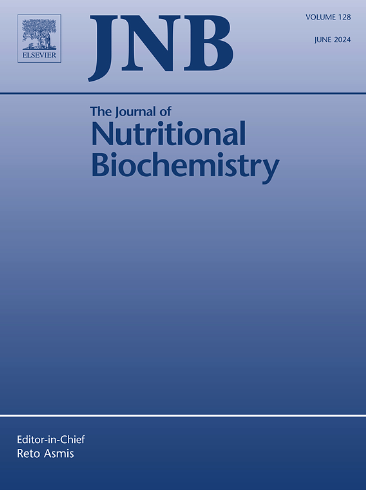The fermentation of whey protein and mulberry polyphenols by forming protein-phenolic adducts: Improved digestions
IF 4.9
2区 医学
Q1 BIOCHEMISTRY & MOLECULAR BIOLOGY
引用次数: 0
Abstract
The impacts of forming adduct between whey protein (WP) and mulberry polyphenol (MP) on the digestion and fermentation of WP and MP were investigated using an in vitro model. The results showed that MP increased the in vitro antioxidant capacity of WP digestive products. After forming adduct the total extractable phenolic content of MP dropped from 440.20 mg GAE/g to 21.53 mg GAE/g. The total extractable phenolic content of WP-MP group decreased from 21.53 mg GAE/g to 11.77 mg GAE/g after the oral digestion, then slightly increased to 12.43 after the gastric digestion and continuously increased to 20.43 mg GAE/g after the intestinal digestion. Extractable individual phenolic compounts exhibited the similar tendency, in which cyanidin-3-O-glucoside, cyanidin-3-O-rutinoside, p-coumaric acid, quercetin and kaempferol were still detectable while protocatechuic and neochlorogenic acid increased after intestinal digestion of WP-MP adduct. Incorporation of MP inhibited the oral and gastric digestion but enhanced the intestinal digestion of WP, and the degree of hydrolysis of WP increased 9.70% after intestinal digestion compared to the control. The fermentation of non-dialyzable residue of WP-MP by gut flora decreased the pH value from 7.18 to 4.82 and increased the proliferation of beneficial bacteria and the production of short-chain fatty acids. These findings indicated that WP-MP adduct increased the digestion of WP and the bioaccessibility of MP, could improve the intestinal health and could be used as a new healthy food ingredient.

通过形成蛋白质-酚类加合物发酵乳清蛋白和桑多酚:改善消化
采用体外模型研究了乳清蛋白(WP)与桑多酚(MP)之间形成加合物对WP和MP消化和发酵的影响。结果表明,MP提高了白蜡多糖消化产物的体外抗氧化能力。加合物形成后,MP的总可萃取酚含量由440.20 mg GAE/g降至21.53 mg GAE/g。WP-MP组总可提取酚含量经口腔消化后由21.53 mg GAE/g下降至11.77 mg GAE/g,经胃消化后略有上升至12.43 mg GAE/g,经肠消化后继续上升至20.43 mg GAE/g。可提取的单个酚类化合物表现出类似的趋势,其中花青素-3- o -葡萄糖苷、花青素-3- o -芦丁苷、对香豆酸、槲皮素和山奈酚在肠道消化WP-MP加合物后仍可检测到,而原儿茶素和新绿原酸则增加。MP的掺入抑制了口服和胃消化,但增强了WP的肠道消化,肠道消化后WP的水解程度比对照组提高了9.70%。肠道菌群对不可透析残渣的发酵使pH值从7.18降至4.82,促进了有益菌的增殖和短链脂肪酸的产生。上述结果表明,WP-MP加合物提高了WP的消化能力和MP的生物可及性,可以改善肠道健康,可作为一种新的保健食品配料。
本文章由计算机程序翻译,如有差异,请以英文原文为准。
求助全文
约1分钟内获得全文
求助全文
来源期刊

Journal of Nutritional Biochemistry
医学-生化与分子生物学
CiteScore
9.50
自引率
3.60%
发文量
237
审稿时长
68 days
期刊介绍:
Devoted to advancements in nutritional sciences, The Journal of Nutritional Biochemistry presents experimental nutrition research as it relates to: biochemistry, molecular biology, toxicology, or physiology.
Rigorous reviews by an international editorial board of distinguished scientists ensure publication of the most current and key research being conducted in nutrition at the cellular, animal and human level. In addition to its monthly features of critical reviews and research articles, The Journal of Nutritional Biochemistry also periodically publishes emerging issues, experimental methods, and other types of articles.
 求助内容:
求助内容: 应助结果提醒方式:
应助结果提醒方式:


